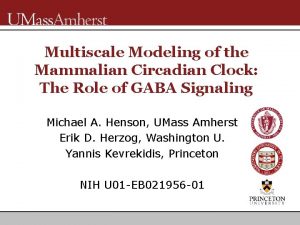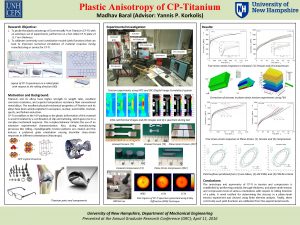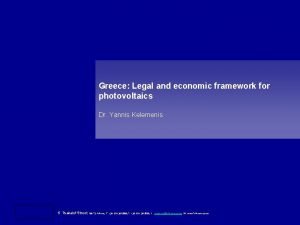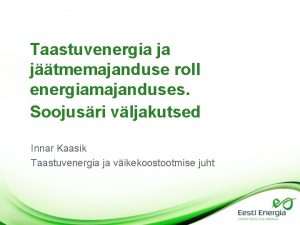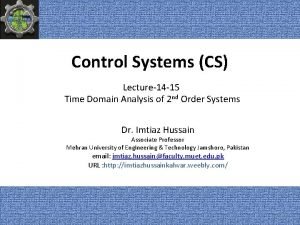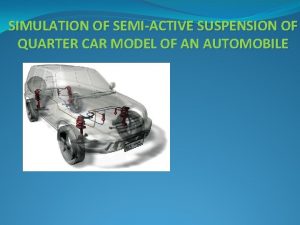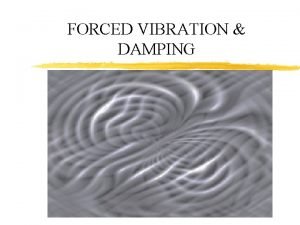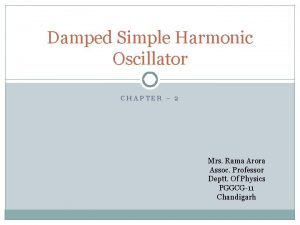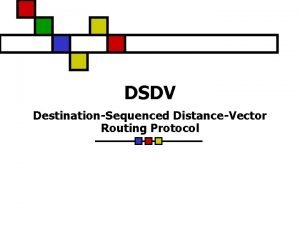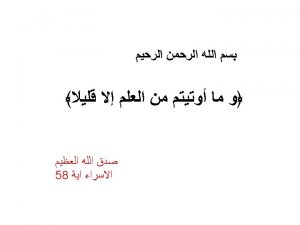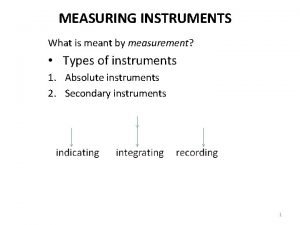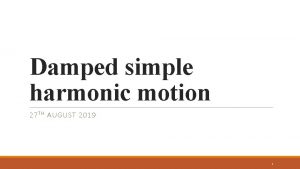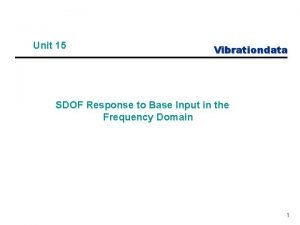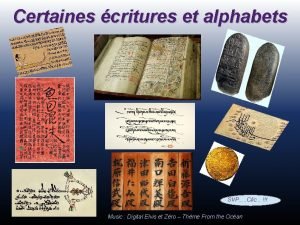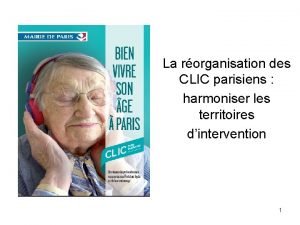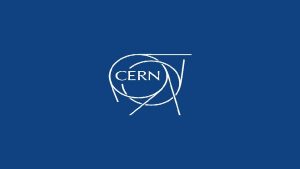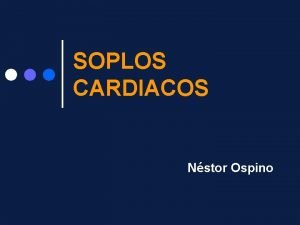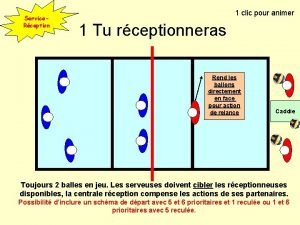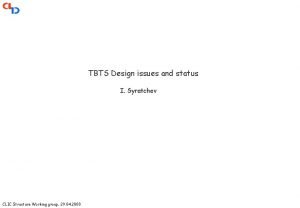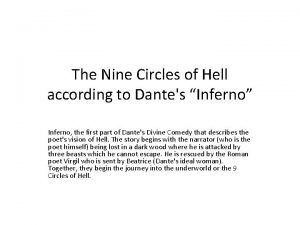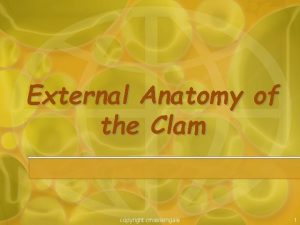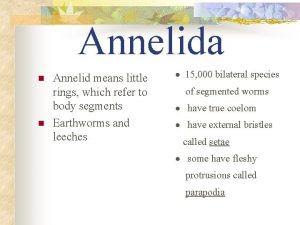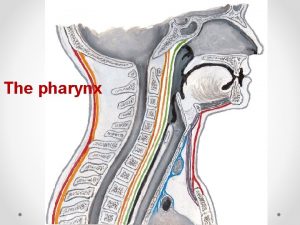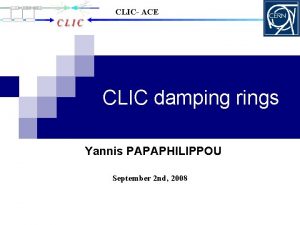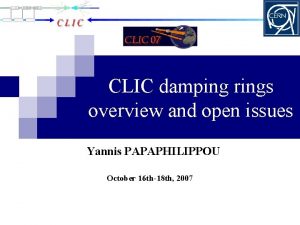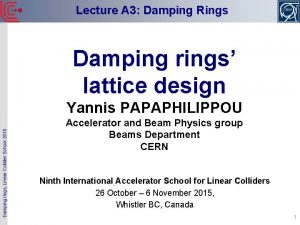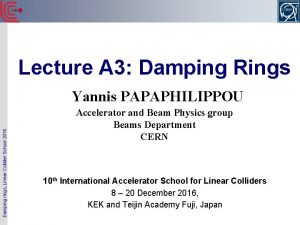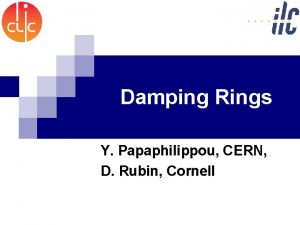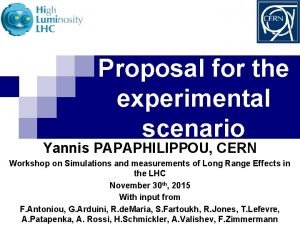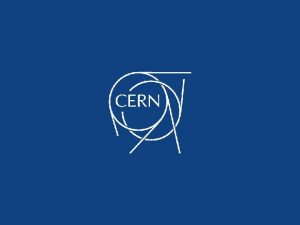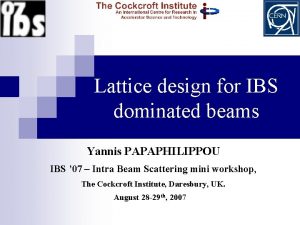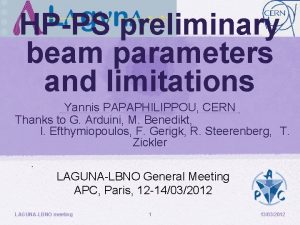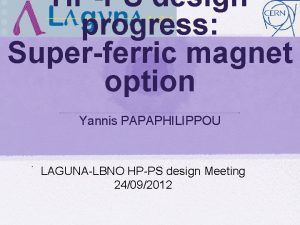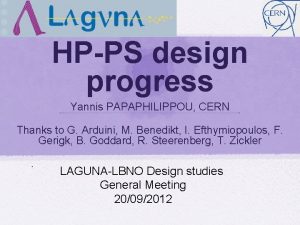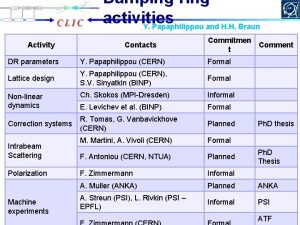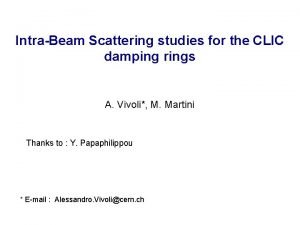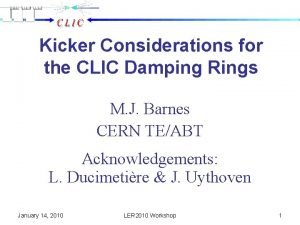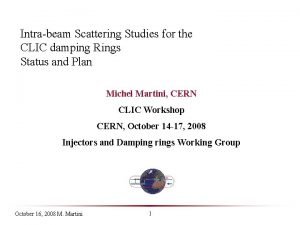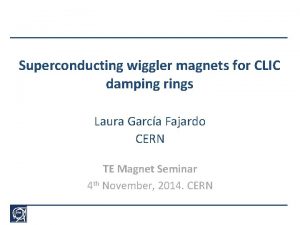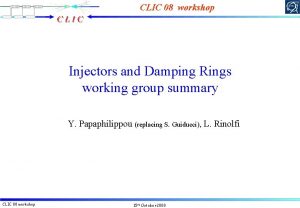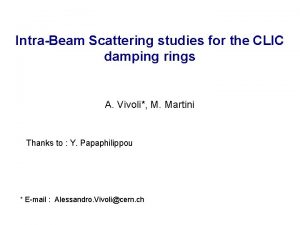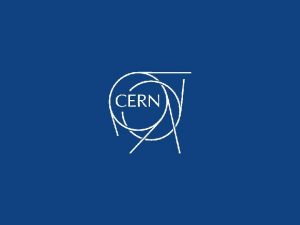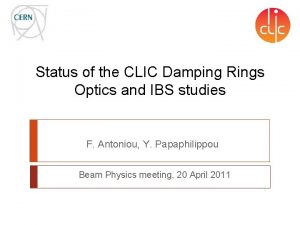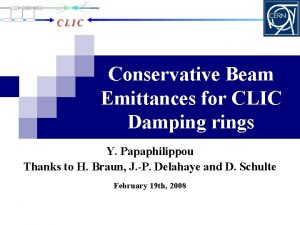CLIC Meeting CLIC damping rings overview Yannis PAPAPHILIPPOU






































![Conservative vertical emittance 1000. 0 1300. 0 1500. 0 ANKA Emittance [pm] SPEAR III Conservative vertical emittance 1000. 0 1300. 0 1500. 0 ANKA Emittance [pm] SPEAR III](https://slidetodoc.com/presentation_image/e44ff969e8ffcbb50bccbe363947db48/image-39.jpg)








- Slides: 47

CLIC Meeting CLIC damping rings overview Yannis PAPAPHILIPPOU September 5 th, 2008

Outline n CLIC damping rings (DR) design goals and challenges n Design parameters’ evolution CLIC parameter note 2005 M. Korostelev, Ph. D thesis, 2006 CLIC parameter note 2007 Design optimisation for CDR (2010) n Lattice choice, optics revision and magnet design n Wiggler design and power absorption n Chromaticity correction and non-linear dynamics n Low emittance tuning in the presence of coupling (tolerances) n e-cloud and other collective effects (IBS) n Parameter scan for damping rings n Diagnostics n CLIC DR activities n Summary Y. P. , 05/09/2008 CLIC Meeting 2

Damping ring design goals PARAMETER NLC CLIC bunch population (109) 7. 5 4. 1 bunch spacing [ns] 1. 4 0. 5 number of bunches/train 192 316 3 1 120 50 Extracted hor. normalized emittance [nm] 2370 <550 Extracted ver. normalized emittance [nm] <30 <5 Extracted long. normalized emittance [ke. V. m] 10. 9 <5 Injected hor. normalized emittance [μm] 150 63 Injected ver. normalized emittance [μm] 150 1. 5 13. 18 1240 number of trains Repetition rate [Hz] Injected long. normalized emittance [ke. V. m] n Ultra-low emittance + high beam polarisation cannot be produced by conventional particle sources: ¨ n Intra-beam scattering due to high bunch current blows-up the beam ¨ n Ring to damp the beam size to desired values through synchrotron radiation Equilibrium “IBS dominated” emittance should be reached fast to match collider high repetition rate Other collective effects (e. g. e--cloud, fast ion instability) may increase beam losses

Injector complex BC 2 e+ Main Linac e- Main Linac 12 GHz, 100 MV/m, 21 km RTML 9 Ge. V Booster Linac 6. 6 Ge. V 12 GHz 2. 4 GV e+ 5 m e+ 3 GHz 88 MV DR e+ BC 1 230 m Thermionic gun Unpolarized e- Positron Drive beam Linac 2 Ge. V 1. 5 GHz 200 m e-/e+ Target 5 m 3 GHz 88 MV e- DR e- PDR e+ PDR 2. 424 Ge. V Pre-injector Linac for e+ 200 Me. V 1. 5 GHz 15 m RTML 12 GHz 2. 4 GV 3 Te. V Base line configuration Rinolfi 3 GHz 500 m 30 m e- BC 2 48 km e- BC 1 Injector Linac 2. 2 Ge. V 2. 424 Ge. V 365 m 100 m 1. 5 GHz 220 m 2. 424 Ge. V 365 m 2. 424 Ge. V 30 m Pre-injector Linac for e 200 Me. V 1. 5 GHz Laser DC gun Polarized e- 0 R ~ 13 m L ~ 1100 m L.

Damping rings’ parameters n 2005: original ring n 2006 a: superconducting wiggler considered n 2006 b: vertical dispersion included n 2007 a: 12 GHz structure n 2007 b: reduced bunch population n 2007 c: CLIC_G structure

CLIC damping rings lattice • Two rings of racetrack shape at energy of 2. 424 Ge. V • Arcs filled with 1. 8 m long TME cells and straight sections contain FODO cells with damping wigglers, giving total length of 365. 2 m • Phase advance per TME cell was kept to 210 o in the horizontal and 90 o in the vertical plane, providing a detuning factor of 1. 8

CLIC damping ring layout Y. P. , 05/09/2008 M. Korostelev, Ph. D thesis, EPFL 2006 7

Arc and wiggler cell n TME arc cell chosen for compactness and efficient emittance minimisation over Multiple Bend Structures used in light sources ¨ ¨ ¨ n Large phase advance necessary to achieve optimum equilibrium emittance Very low dispersion Strong sextupoles needed to correct chromaticity Impact in dynamic aperture Very limited space Extremely high quadrupole and sextupole strengths FODO wiggler cell with phase advances close to 90 o giving Average β’s of ~ 4 m and reasonable chromaticity ¨ Quad strength adjusted to cancel ¨

New wiggler cell n n n Added space between wiggler and downstream quadrupoles for accommodating absorbers 30%� increase of the wiggler section length Slight increase of beta maxima (and chromaticity) S. Sinyatkin, et al. , 2008 Y. P. , 05/09/2008 9

Proposed arc cells Structure version S. Sinyatkin, et al. , 2008 V 04 Energy [Ge. V] Circumference [m] Losses per turn [Me. V/turn] V 04 V 06 2. 424 365. 21 Coupling 534 493. 05 0. 0006 3. 8600 3. 9828 4. 38 4. 35 4. 601 Natural chromaticity x / y -103 / -136 -186/ -118 -148. 8 / -79. 0 Compaction factor 8. 0213 E-05 4. 56 E-05 6. 4427 E-05 Damping time x / s [ms] 1. 53 / 0. 76 2. 17 / 1. 09 1. 99 / 1. 01 3. 5 / 6 1. 5 / 5 12 / 50 RF voltage [MV] Dynamic aperture a/σinj x / y Number of arc cells 100 Number of wigglers 76 Cell length [m] Dipole length [m] Bend field [T] Bend gradient [1/m^2] V 06 Original 1. 729 2. 300 0. 544944 0. 93 1. 27 0 0 -1. 10 Max. Quad. gradient [T/m] 220 107. 7 60. 3 Max. Sext. strength [T/m^2]*103 80 24. 1 6. 59 0. 581 / 0. 248 0. 524 / 0. 183 0. 442 / 0. 045 Phase advance x / z Bunch population, N*10^9 IBS gain factor 4. 1 5. 1831 3. 62 2. 89 449 439. 26 428. 4 Bunch length [mm] 1. 402 1. 450 1. 380 Longitudinal emmitance [e. Vm] 5339 5694 5188 Normalized Emittance [nm*rad]

Arc magnet design P. Vobly, et al. , 2008 n n Quadrupoles High gradient quadrupole model using conventional technology (120 T/m, r=10 mm) Hybrid quadrupole and sextupole designs for even higher field (140160 T/m and 28 T/m 2 ) sextupole

Wigglers’ effect with IBS n Stronger wiggler fields and BINP PM wiggler n BINP SC wiggler ANKA SC wiggler n shorter wavelengths necessary to reach target emittance due to strong IBS effect The longitudinal emittance has a different optimum but it can be controlled with the RF voltage With super-conducting wigglers of 2. 5 T and 5 cm period, the achieved normalized horizontal emittance drops below 400 nm ¨ Super-conducting magnets have to be designed, built and tested Y. P. , 05/09/2008 CLIC Meeting 12

n Wiggler prototypes Two wiggler prototypes ¨ ¨ n n n 2. 5 T, 5 cm period, built by BINP 2. 8 T, 2. 1 cm period, built by CERN/ANKA Parameters BINP ANKA/CERN Bpeak [T] 2. 5 2. 8 λW [mm] 50 40 Beam aperture full gap [mm] 20 24 Nb. Ti Nb. Sn 3 4. 2 Aperture of 20 -25 mm Conductor type Current density can be Operating temperature [K] increased by using different conductor type Establish field error tolerances for both designs Short version to be installed and tested at ANKA Measurements of emittance growth due to IBS in a wiggler dominated ring (ANKA at injection energy of 0. 5 Ge. V)

Nb. Ti wiggler design P. Vobly, et al. , 2008 Parameter Energy CLIC-DR General view for BINP wiggler prototype 2. 424 Ge. V Beam Current Parameter Regular coil 170 m. A Iron yoke BINP wiggler CERN wiggler Nb. Ti Nb 3 Sn 2. 5 2. 8 5 4 Magnetic gap of wiggler, mm 20* 24* Number of periods 40 50 SR critical energy, ke. V 9. 62 10. 8 Deflection parameter 11. 7 10. 5 SR power, k. W 7. 90 9. 91 60 (LN) 4. 2 (LHe) Critical longitudinal power density over VC, W/m 10 1 VC vertical aperture, mm 12 16 Length of wiggler, m 2 2 Coils material Maximal magnetic field, T Period of wiggler, cm VC temperature, K Y. P. , 05/09/2008 CLIC Meeting Corrector coils with individual PS End coils to compensate the first and the second integral Internal Cu liner with LN temperature protects LHe elements from SR A cryogenic cooler SUMITOMO SRDK 408 S 2 permits evacuate up to 50 W power from 60 K liner. 14

Synchrotron radiation absorption K. Zolotarev, et al. , 2008 Y. P. , 05/09/2008 Regular absorbers of 26 k. W for PETRA-III project CLIC Meeting 15

Wiggler gap and vertical collimator size K. Zolotarev, et al. , 2008 n n CERN wiggler more challenging due to 1 W/m power limit Gap of 13 mm for Nb. Ti wiggler and 20 mm for Nb 3 Sn design A 4 -wigglers scheme CERN wiggler Zoomed BINP wiggler Y. P. , 05/09/2008 CLIC Meeting 16

Radiation distribution K. Zolotarev, et al. , 2008 Odd number collimator BINP wiggler version 80 x 6 mm, P=7. 9 k. W Even number collimator 63 x 12 mm, P=7. 9 k. W Even number wiggler VC load distribution, P=9. 4 W

Final absorber K. Zolotarev, et al. , 2008 6 m length final absorber can absorb up to 170 k. W of SR power

Non-linear dynamics n Two sextupole schemes ¨ n 2 and 9 families of sextupoles With the 9 family scheme tha Dynamic aperture is 9σx in the horizontal and 14σy in the vertical plane (comfortable for injection)

Dynamic aperture Original n n V 04 Original and V 04 lattices have very small DA The V 06 lattice has a more comfortable DA Error tables for all magnets including superconducting wigglers to be considered and optimised Resonance correction and DA optimisation with sextupoles and/or S. Sinyatkin, et al. 2008 V 06

SABA 2 integrator performance n The accuracy of the SABA 2 C was proved an order of magnitude more precise than the Forest-Ruth 4 th order integrator Nadolski and Laskar, EPAC 2002

Application to the ESRF n Consider the old ESRF “ideal” lattice, i. e. perfectly symmetric (periodicity of 16) with the only nonlinearity coming from the sextupoles n Integrate the equations of motions with three different methods ¨ “Drift-Kick” method by splitting the 0. 4 m sextupoles in a drift + kick + drift ¨ Splitting the sextupoles in 10*(drift + kick) + drift ¨ Using the SABA 2 C symplectic integrator n Produce frequency maps by using Laskar’s NAFF algorithm and compare 26/05/2008 ESRF workshop 2008 22

Frequency map I n Comparison between frequency maps produced by “drift-kick” 1 kick versus 10 kicks (3, -2) (0, 5)

Frequency map II n Frequency map using the SABA 2 C symplectic integrator reproduces the “ 10 -kick” case 26/05/2008 ESRF workshop 2008 24

Diffusion maps 1 -kick n Diffusion map using the SABA 2 C symplectic integrator shows lower horizontal and slightly higher vertical DA 26/05/2008 than 1 -kick integrator ESRF workshop 2008 n Colour coding following the logarithm of the diffusion vector amplitude SABA 2 C 25

Frequency maps Ch. Skokos and Y. Papaphilippou, EPAC 08 n n Only sextupole non-linearity considered (two families) Small DA confirmed by both tracking with symplectic integrator SABA 2 C and MADX-PTC First on-momentum frequency map reveals wide vertical tune spread and crossing of a multitude of resonances (especially 4 th order for present working point) On-going effort to include in tracking all relevant effects (dipole and quadrupole fringe fields, wigglers, magnet errors, space-charge, radiation damping) Y. P. , 05/09/2008 CLIC Meeting 26

Effect of radiation damping Levichev (2007) 0. 12 ms 1. 8 ms 3. 6 ms 0. 6 ms 2. 4 ms 4. 2 ms 1. 2 ms 3 ms 4. 8 ms n Damping to the stable resonance islands? n 26/05/2008 Including radiation damping and excitation shows that 0. 7% of the particles are lost during the damping Certain particles seem to damp away from the beam core, on resonance islands ESRF workshop 2008 27

n n n n Coupling correction Correction with dispersion free steering (orbit and dispersion correction) Skew quadrupole correctors for correcting dispersion in the arc and emittance minimisation Iteration of dynamic aperture evaluation and optimisation after correction In CLIC damping rings, the effect of vertical dispersion is dominant (0. 1% of coupling and 0. 25μm of dispersion invariant) Effect of super-conducting wigglers field errors to be included Review of linear correction systems with realistic magnet parameters and reestablishment of alignment tolerances Experimental low-emittance tuning in collaboration with SLS

e--cloud effect n n Simulations with ECLOUD revealed importance of the effect in both CLIC and TESLA DRs Chamber s Dipole SEY 0. 00057 6 1. 3 0. 04 1. 8 2 1. 3 7 1. 8 40 1. 3 0. 6 1. 3 45 1. 5 70 1. 8 80 D. Schulte, R. Wanzerberg , F. Zimmerman, ECLOUD’ 04 0. 0576 Simulations using the FAKTOR 2 code confirmed the importance of the effect 0. 00109 G. Rumolo et al. , EPAC 08 Ante-chambers in dipoles and wigglers need to absorb 99. 9% of photon flux ¨ Secondary emission yield has to be less than 1. 3 ¨ e-cloud density of 3 -5 x 1012 m-3 in the wigglers (independently of density in dipoles) for beam to be stable Wiggler ρ e-/m 3] PEY 0. 109 [1012 ¨ n Simulations to be carried out for CLIC Meeting Y. P. , 05/09/2008 newest parameter set including ρwig = 5 x 1012 m-3, ρdip = 3 x 1011 m-3 29

n n e--cloud countermeasures Coating of vacuum chambers by a material (e. g. NEG, CNe) for lowering secondary emission yield (tested in SPS) Clearing electrodes Solenoids in field-free regions Grooved surface of vacuum chamber ¨ ¨ ¨ L. Wang et al. , PAC 2007 Simulations showing reduction of SEY Verified experimentally in PEPII Slight resistive wall impedance increase courtesy by M. Pivi

Other collective effects n G. Rumolo et al. , EPAC 2008 Longitudinal and transverse broad band impedance requirements not too stringent Based on analytical estimates, a few Ohms in longitudinal and MOhms in transverse are acceptable for stability ¨ Detailed vacuum chamber design and impedance budget are needed ¨ n n Coherent Synchrotron radiation has a minor effect in bunch lengthening Vertical incoherent space-charge tune-shift higher than the acceptable value of 0. 1 To be taken into account in non-linear dynamics and working point choice ¨ Pessimistic estimates from HEADTAIL simulations show a 10% emittance increase ¨ n n Fast ion instabilities necessitates vacuum pressure of < 0. 1 n. Torr Touschek lifetime large enough compared to store time

Intrabeam scattering IBS'07 Intra Beam Scattering Mini Workshop The Cockcroft Institute, Daresbury, UK. 28 th - 29 th August 2007 n In the case of IBS dominated beams, all lattice parameters can be optimised for reaching the target emittance including IBS effect through semi-analytical approach (modified Piwinski or Bjorken-Mtingwa formalism) n n n The effect of IBS is evaluated “a posteriori”, i. e. after setting up the basic features of the lattice An iterative process can be used in order to scan the full parameter space and reach the optimum, using numerical tools Lack of a unique tool for executing all the optimisation steps and reiterate if needed. Derive analytically the optics parameters for reaching minimum IBS dominated emittance in selected lattices (FODO, TME, …) Numerical or analytical approach for effect of strong IBS producing non-Gaussian tails including radiation damping is missing n Codes for non-Gaussian beams exist (e. g. MOCAC) but not all effects

Injection, extraction, timing, RF • • Interleaved bunch train scheme abandoned due to its complexity. Reduction of the repetition rate from 150 to 50 Hz leaves enough time for the emittances to reach their equilibrium. Bunch spacing increased almost to the same level as for the interleaved scheme. 312 bunches with 0. 5 ns spacing, fill only 13% of the rings. RF frequency of 2 GHz with voltage of 4. 1 MV for enough energy recovery while keeping longitudinal emittance below 5000 e. V. m Extraction kicker rise time relaxed Meeting 33 Y. P. , 05/09/2008 Detailed design of RFCLIC cavity and injection/extraction

Bunch charge and longitudinal emittance • Horizontal emittance scales as • Vertical and longitudinal emittance have weaker dependence to bunch charge (of the same order) confirming that vertical emittance dominated by vertical dispersion. • When relaxing longitudinal emittance constraint of 5 ke. V. m (decreasing RF voltage), horizontal emittance presents inverse square root dependence (reduced by 25%) • Vertical emittance dependence is CLIC much weaker Meeting 34 Y. P. , 05/09/2008

Horizontal emittance vs. energy n The horizontal emittance is with the relative damping factor n Assume the damping partition number dipoles) and constant bending angle (i. e. no gradient in and dipole field. As , the dipole length and the circumference should be scaled as well with energy n Scaling the total wiggler length with energy damping factor energy independent n The average beta function in a wiggler FODO cell is makes the relative and scales as the wiggler length or the energy, considering constant focal length n Keeping the wiggler characteristics (field, period) constant, the first term is scaled with the square of the energy whereas the second is energy independent CLICemittance Meeting 35 Y. P. , 05/09/2008 n Finally, the horizontal normalized is

Longitudinal emittance vs. energy n The longitudinal normalised emittance can be defined as n The slippage factor is approximately equal to the momentum compaction factor which can be written as n Under the previous assumptions the momentum compaction factor is energy independent n The synchrotron frequency is account that the harmonic number is and taking into , the synchrotron frequency is assuming an increase of the RF voltage with the energy loss per turn n The bunch length is n The momentum spread CLIC Meeting Y. P. , 05/09/2008 n Finally the longitudinal normalised emittance is 36

IBS dominated emittances vs. energy • • • Numerical scaling obtained, by integrating coupled difference equations of standard IBS theory. Longitudinal and horizontal emittance scale approximately as and For constant longitudinal emittance • • high energies (small effect of IBS): horizontal emittance follows power law similar to the one of zero current emittance low energies (IBS dominates): is inversely proportional to the energy Y. P. , 05/09/2008 CLIC Meeting 37

IBS dominated emittances vs. energy • • Vertical emittance follows a quadratic polynomial law For constant longitudinal emittance, it scales linearly with energy for high energies. For low energies saturates to constant value. Y. P. , 05/09/2008 CLIC Meeting 38
![Conservative vertical emittance 1000 0 1300 0 1500 0 ANKA Emittance pm SPEAR III Conservative vertical emittance 1000. 0 1300. 0 1500. 0 ANKA Emittance [pm] SPEAR III](https://slidetodoc.com/presentation_image/e44ff969e8ffcbb50bccbe363947db48/image-39.jpg)
Conservative vertical emittance 1000. 0 1300. 0 1500. 0 ANKA Emittance [pm] SPEAR III 100. 0 ELETTRA ALBA ASTRID MAXIV BESSY II APS CESR-TA 10. 0 ALS ATF NLC SLS ESRF DIAMOND SOLEIL CLIC 1. 0 0. 00 PETRA III NSLSII 2. 00 Spring-8 USR ILC PEP LS 4. 00 6. 00 Energy [Ge. V] 8. 00 10. 00 n Swiss Light Source achieved 2. 8 pm, the lowest geometrical vertical emittance, at 2. 4 Ge. V, corresponding to ~10 nm of normalised emittance n Below 2 pm, necessitates challenging alignment tolerances and low emittance tuning (coupling + vertical dispersion correction)

Horizontal emittance vs. energy v NLC CLIC v Z. Zhao, PAC’ 07 n NSLS II v ILC 0. 6 nm @ 3 Ge. V, including damping wigglers and

Scaling of NSLS II parameters n The “zero-current” equilibrium emittance scaled to CLIC DRs energy is 1. 6µm n Under previous assumptions, give longitudinal normalized emittance of 6256 e. V. m @ 2. 424 Ge. V n Taking into account scaling of horizontal emittance with bunch population and longitudinal emittance the hor. norm. emittance for CLIC DR parameters (4. 1 x 109 p/bunch and 5000 e. V. m) is 1. 3µm n The final horizontal emittance after scaling the IBS growth with the energy and the vertical emittance, is 2. 5µm n In this respect the final value may lie around 2µm providing a safe compromise Y. P. , 05/09/2008 PARAMETER Values energy [Ge. V] 3 circumference [m] 791. 5 bunch population [109] 7. 9 bunch spacing [ns] 1. 9 number of bunches 1056 rms bunch length [mm] 2. 9 rms momentum spread [%] 0. 1 hor. normalized emittance [µm] 2. 99 ver. normalized emittance [nm] 47 lon. normalized emittance [e. V. m] 10395 coupling [%] 0. 64 wiggler field [T] 1. 8 wiggler period [cm] 10 RF frequency [GHz] 0. 5 CLIC Meeting 41

Damping Rings diagnostics n Beam position from around 300 PUs, turn by turn (every 1. 22μs) all around the ring with a ¨ ¨ n n n 10μm resolution, for linear and non-linear optics measurements. 2μm resolution for orbit measurements (needed for vertical dispersion/coupling monitoring and correction and closed orbit feedback). A few wide band pick-ups able to do bunch-by-bunch (bunch spacing of 0. 5 ns for 312 bunches) and turn by turn position monitoring with a high resolution (1μm) for injector trajectory control, and bunch by bunch transverse feedback. Some pick-ups or profile monitors for the extraction transfer line for extraction orbit control and feed-forward. Tune monitors and fast tune feed-back precision of 10 -4). The vertical tune may move roughly by 0. 2 due to spacecharge. The precision of these monitors may be critical for resolving instabilities (i. e. synchrotron side-bands, ions) Y. P. , 05/09/2008 CLIC Meeting 42

Damping Rings diagnostics n Turn by turn transverse profile monitors (X-ray? ) with a wide dynamic range: the horizontal geometrical emittance goes roughly from 13 nm. rad at injection to 80 pm. rad at extraction and the vertical from 300 pm. rad to 0. 8 pm. rad. ¨ Capable of measuring tails for an IBS dominated beam. ¨ This would probably be the most challenging item. ¨ n Longitudinal profile monitors Energy spread of 0. 5% to 0. 1% and bunch length from 10 to 0. 1 mm. ¨ Note that the dispersion around the ring is extremely small (<12 mm). ¨ n n n Fast beam loss monitoring and bunch-by-bunch current measurements E-cloud + ion diagnostics (vacuum) LBNL colleagues showed interest to work on certain items during CLIC workshop 2007 Y. P. , 05/09/2008 CLIC Meeting 43

Damping ring activities Y. Papaphilippou and H. H. Braun Activity Contacts Commitmen t Comment DR parameters Y. Papaphilippou (CERN) Formal Lattice design Y. Papaphilippou (CERN), S. V. Sinyatkin (BINP) Formal Ch. Skokos (MPI-Dresden) Informal E. Levichev et al. (BINP) Formal R. Tomas, G. Vanbavickhove (CERN) Planned M. Martini, A. Vivoli (CERN) Formal F. Antoniou (CERN, NTUA) Planned F. Zimmermann (CERN) Informal A. Muller (ANKA) Planned ANKA A. Streun (PSI), L. Rivkin (PSI – EPFL) Informal PSI Non-linear dynamics Correction systems Intrabeam Scattering Polarization Machine experiments Y. P. , 05/09/2008 CLIC Meeting Ph. D thesis Ph. D Thesis ATF 44

Damping ring activities Commitmen t Comment R. Rossmanith (ANKA), R. Maccaferi (CERN) Planned Nb 3 Sn E. Levichev (BINP) Formal Nb. Ti Radiation absorption K. Zolotarev, P. Vobly (BINP) Formal Pre-damping rings F. Antoniou (CERN, NTUA) Formal J. Byrd, S. de Santis (LBNL) Planned T. Lefevre (CERN) Formal E. Jensen, A. Grudiev (CERN) Planned V. Serriere (ESRF) Informal Harmonic cavities S. De Santis (LBNL) Informal Injection/Extraction T. Fowler, M. Barnes (CERN) Formal Alignment J. P. Quesnel (CERN) Planned Stabilization C. Hauviller (CERN) Planned Feed-back To be confirmed Activity Super-conducting wiggler Instrumentation RF design Y. P. , 05/09/2008 Contacts CLIC Meeting 45

Damping ring activities Collective effects: G. Rumolo Activity Contacts Commitmen t G. Rumolo (CERN), W. Bruns Formal M. Pivi (SLAC) Planned Chamber coating P. Chiggiato (CERN), R. Kersevan(ESRF) Planned Space-charge D. Quatraro (CERN), E. Levichev (BINP) Formal Impedances A. Wolski, M. Korostelev (Cockcroft Institute) Planned Instabilities G. Rumolo , D. Quatraro (CERN) Formal Vacuum design To be confirmed e-cloud / ions Comment Cut by EUCARD 36 contact persons from CERN(19), BINP(4), Cockroft(2), ESRF(2), SLAC(1), LBNL (2), ANKA(2), PSI(2), MPI(1), CLIC Meeting Y. P. , 05/09/2008 Private(1) 46

Summary n Detailed design of the CLIC damping rings, delivering target emittance with the help of super-conducting wigglers ¨ ¨ ¨ n Prototype to be built and tested at ANKA synchrotron Radiation absorption protection Collective effects evaluation including electron cloud and fast ion instability Lattice revision for becoming less challenging with respect to space and magnet parameters ¨ Sextupole optimisation and non-linear dynamics including wiggler field errors n ¨ n n Linear and non-linear correction schemes Low emittance tuning and alignment tolerances Parameter scan for conservative beam emittances for 500 Ge. V collider Work in progress Pre-damping rings optics design IBS theory, numerical tools and experimental demonstration of low emittance ¨ Vacuum chamber design and impedance budget ¨ Injection and extraction elements ¨ ¨
 Yannis kevrekidis
Yannis kevrekidis Madhav baral
Madhav baral Yannis kelemenis
Yannis kelemenis Yannis labrou
Yannis labrou Yannis zerari
Yannis zerari Those who are loved poem by yannis ritsos
Those who are loved poem by yannis ritsos What is meeting and types of meeting
What is meeting and types of meeting Types of meeting
Types of meeting For todays meeting
For todays meeting Proposal kickoff meeting agenda
Proposal kickoff meeting agenda Roll damping
Roll damping Peak time
Peak time Damper in suspension system
Damper in suspension system Heavy damping
Heavy damping Relaxation time of damped harmonic oscillator
Relaxation time of damped harmonic oscillator Simple harmonic motion formulas
Simple harmonic motion formulas Damping in dsdv
Damping in dsdv Supraspinal
Supraspinal Atwood's classification of residual ridges
Atwood's classification of residual ridges Uses of voltmeter
Uses of voltmeter Logarithmic decrement formula
Logarithmic decrement formula Damping torque definition
Damping torque definition Damping coefficient c
Damping coefficient c Types of secondary instruments
Types of secondary instruments Clic music
Clic music Clic paris emeraude
Clic paris emeraude Dead clic
Dead clic Clic
Clic Chanson clic clac saint nicolas
Chanson clic clac saint nicolas Rey orozco
Rey orozco Mesosistolico
Mesosistolico Rception
Rception Cern clic
Cern clic Sales double entry
Sales double entry Hacer clic en ingreso al sistema 1102-404
Hacer clic en ingreso al sistema 1102-404 Clic
Clic Clic sequr citoyen
Clic sequr citoyen Cuantas letras hay
Cuantas letras hay Imagenes de clic
Imagenes de clic This phylum name means “little rings”
This phylum name means “little rings” Comfort device assignment
Comfort device assignment The nine circle of hell
The nine circle of hell Sharroky hollie rings of culture
Sharroky hollie rings of culture External anatomy of clam
External anatomy of clam Roberta ran rings around the roman ruins
Roberta ran rings around the roman ruins Means little rings
Means little rings Lipids made up of rigid carbon rings
Lipids made up of rigid carbon rings Stylopharyngeus
Stylopharyngeus
